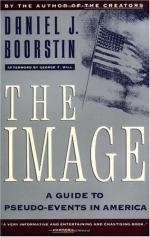|
This section contains 803 words (approx. 3 pages at 400 words per page) |

|
Graphic Revolution
Boorstin continually references the Graphic Revolution as playing a major role in the development of pseudo-events. He states, "It brought new forces toward popularizing, toward reshaping - and toward disembodying - works of art". These changes occurred in several ways. First, the invention of paper-making machines and "cylinder presses" significantly reduced the time and cost involved with producing books. In addition, machines were developed that improved the bookbinding process and the production of book covers. Due to these advancements, booksellers were able to produce and sell many more books for less money. This in effect made books a commodity.
A similar change occurred in the field of "graphic arts" as well. New technologies allowed for the reproduction of famous works into prints as well as adornments for coffee mugs, notepads, flags, etc. Newspapers began to have access to reproduced photographs as well as color printing techniques. Other...
|
This section contains 803 words (approx. 3 pages at 400 words per page) |

|




